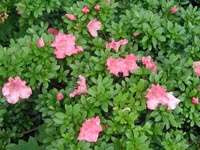Resource Library
Plant of the Week: Gumpo Azalea
The University of Arkansas System Division of Agriculture does not promote, support or recommend plants featured in "Plant of the Week." Please consult your local Extension office for plants suitable for your region.
Plant of the Week
[A-Z]
Gumpo Azalea
Latin: Rhododendron 'Gumpo'

Without azaleas, springtime in the South would be incomplete. April is the month of peak bloom across Arkansas with a few outliers blooming in March or early May. But one group, the Satsuki azaleas, breaks all the rules and blooms in late May and June. The most common of these late bloomers is the ‘Gumpo’ azalea.
The Gumpo azalea is a spreading evergreen shrub seldom over 2 feet high and 3 feet wide. The leaves are of the typical azalea type, but on the small size, usually less than an inch and a half long.
The true Gumpo azalea has white, ruffled 3-inch wide flowers that are irregularly splotched with flecks of pinkish-purple. Color sports have been selected with the light pink ‘Gumpo Pink’ being the most common. ‘Gumpo White’ is also common. ‘Gumpo Fancy’ is pink with a white margin. Of course, there is also a ‘Gumpo Red.’
The Japanese have been growing azaleas for centuries and have traditionally classified azaleas into two groups, the Tsutsuji and the Satsuki. This classification system was codified in 1692 in their first book on azaleas, Kinshu Makura. The Tsutsuji azaleas bloom one lunar cycle after the spring equinox and comprise the most popular azaleas in the U.S.; the Satsuki bloom two lunar cycles after the vernal equinox. The word Satsuki means "fifth month" in relation to the fifth month of the lunar calendar.
In the United States, the Satsuki azaleas have never been as popular as the early spring bloomers because the flowers are produced after the spring flush of growth, not before as in the Tsutsuji group. This means that the large flowers are partially hidden in the foliage, playing peek-a-boo when they finally appear.
But, in Japan, the Satsuki azaleas have always been more popular, primarily because their traditional garden style relies on form and inference, with little emphasis on gaudy displays of color like we decadent Westerners enjoy. The azaleas are closely sheared, often to simulate rock outcrops. Obviously, a bunch of flowers on your simulated rocks would ruin the illusion. The Satsuki azaleas are also traditionally used for bonsai work.
The Satsuki azaleas are thought to have originated in southern Japan as natural hybrids between Rhododendron indicum that occupies the mountaintops and R. tamurae that is located at or near sea level. Gumpo, which translates as "a group of phoenixes," is an old cultivar that has long been grown in Japan.
Who introduced it into the United States is not known, but it has been here since the early 1900s. To date, about 500 Satsuki azaleas have been introduced, many of them collected by Berry Yinger in 1978, while he was working for the Brookside Botanic Garden in Wheaton, Md.
Gumpo azaleas are not as winter hardy as many of the more common evergreen azaleas. Most consider them suitable for only Zone 7 and south, but thanks to global warming, they seem to do just fine in northern Arkansas.
Other than their late blooming characteristic, they are grown just as any other azalea, being sure to provide a soil pH between 5.2 and 6.0 and a moist, but well-drained medium. Azalea lacebugs also afflict the Gumpo azaleas.
By: Gerald Klingaman, retired
Extension Horticulturist - Ornamentals
Extension News - May 30, 2003
The University of Arkansas System Division of Agriculture does not maintain lists of retail outlets where these plants can be purchased. Please check your local nursery or other retail outlets to ask about the availability of these plants for your growing area.